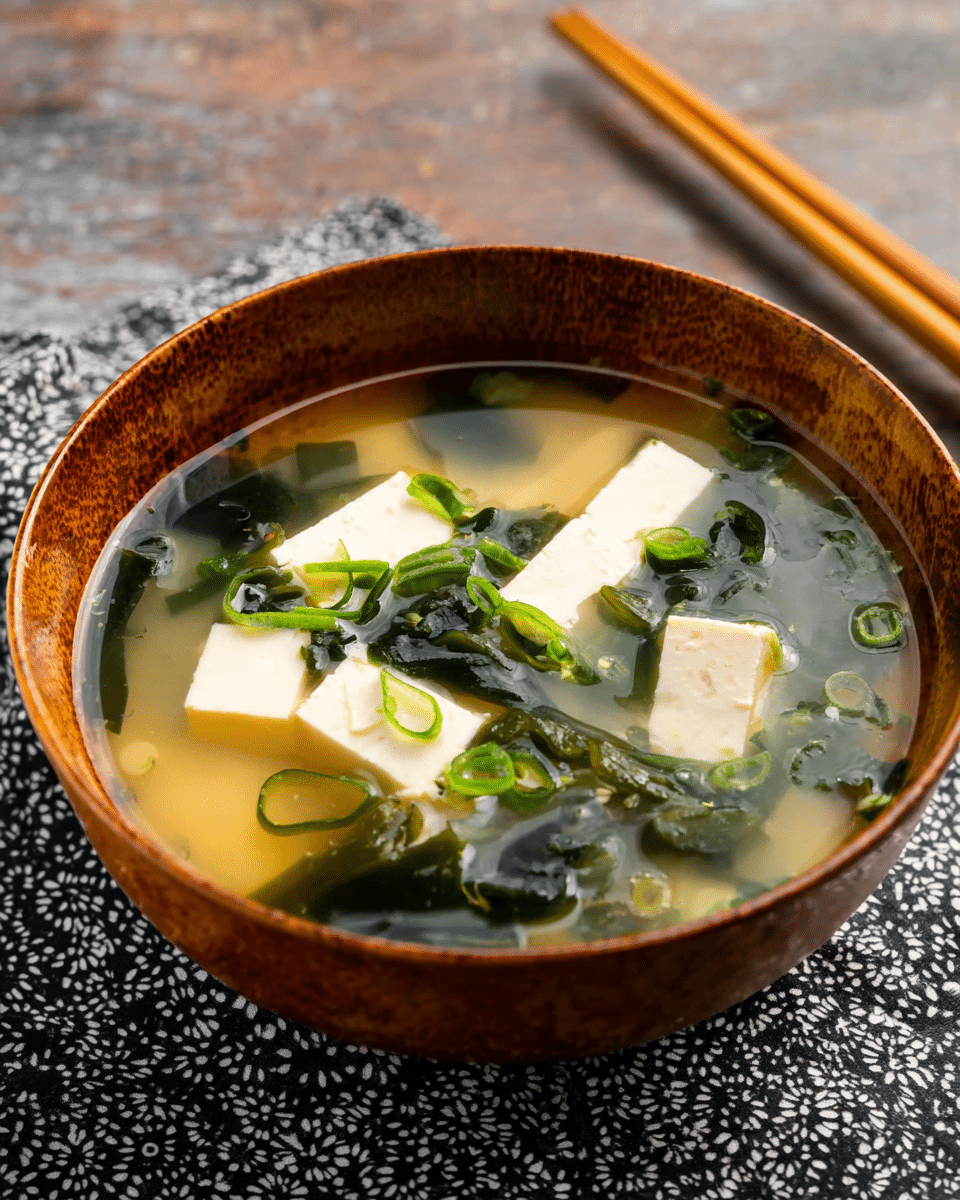The essence of Japanese comfort food, Miso Soup is beloved for its deep umami flavor and nourishing qualities. Made from a delicate blend of dashi broth and fermented miso paste, this soup is often enhanced with simple yet flavorful additions like tofu, seaweed, and green onions. It’s a staple in Japanese households, often served as a starter for breakfast, lunch, or dinner.
Despite its simplicity, miso soup is a powerful representation of balance in Japanese cooking offering warmth, richness, and nourishment with just a handful of ingredients. It’s easy to make at home and endlessly customizable with seasonal vegetables or proteins. Whether you’re new to Japanese cuisine or a seasoned fan, this dish is a must-have in your cooking repertoire.
Full Recipe:
Ingredients:
-
4 cups dashi (Japanese soup stock)
-
3 tablespoons miso paste (white or red)
-
1/2 cup silken tofu, diced
-
2 tablespoons wakame seaweed (dried)
-
2 tablespoons sliced green onions
Directions:
-
In a medium saucepan, bring the dashi to a gentle simmer over medium heat.
-
Soak the dried wakame in a small bowl of water for about 5 minutes, then drain and set aside.
-
Lower the heat to medium-low and add the tofu and rehydrated wakame to the dashi. Simmer for 1-2 minutes, being careful not to let the soup boil.
-
Turn off the heat. In a small bowl, dissolve the miso paste in a ladleful of the hot dashi until smooth. Stir the miso mixture back into the pot.
-
Add sliced green onions and gently stir. Serve immediately while warm.
Prep Time: 5 minutes | Cooking Time: 10 minutes | Total Time: 15 minutes
Kcal: 60 kcal | Servings: 2 servings
Miso soup is one of the most iconic dishes in Japanese cuisine a humble, warming bowl that carries centuries of culinary tradition and cultural significance. Often served at breakfast, lunch, and dinner, this simple yet flavorful dish is a staple in nearly every Japanese household. With its umami-rich taste and health-boosting properties, miso soup is much more than a side dish; it is a cornerstone of mindful eating, seasonal awareness, and balanced nutrition.
In this article, we’ll explore the origins, nutritional benefits, cultural significance, variations, and the reasons behind miso soup’s enduring popularity both in Japan and around the world.
The Cultural Importance of Miso Soup in Japanese Cuisine
Miso soup is far more than just a culinary choice it’s a daily ritual in many Japanese homes. In traditional Japanese meals, it is often paired with rice and pickles, forming the essential “ichiju-sansai” meal structure (one soup and three sides). This arrangement reflects a deep-rooted philosophy of harmony and balance in food, representing the cultural values of health, variety, and seasonality.
In many households, children grow up drinking miso soup as part of their breakfast. It’s not unusual for it to be served at every meal, and while the core ingredients remain the same miso paste and dashi (Japanese soup stock) each family has its own variation depending on regional customs, available produce, and personal preference.
In Japanese Buddhist culture, miso soup also plays a role in ceremonial meals, often served in a more minimalistic form to reflect simplicity and spiritual mindfulness. The act of making and consuming miso soup is almost meditative a practice that embodies care, intention, and respect for the ingredients.
Understanding the Core Components
At its base, miso soup is made of two primary components: dashi and miso paste.
Dashi is a traditional Japanese broth made from kombu (dried kelp) and katsuobushi (dried bonito flakes). It is the foundation of many Japanese dishes and provides the subtle, savory depth known as umami. A vegetarian version of dashi can be made using only kombu or a combination of kombu and dried shiitake mushrooms, making the soup adaptable to various dietary preferences.
Miso paste is made from fermented soybeans and comes in different varieties: white (shiro), red (aka), and mixed (awase). Each has a distinct flavor profile white miso is mild and slightly sweet, red miso is strong and salty, while awase miso offers a balanced blend of the two. The type of miso used can dramatically alter the character of the soup.
Additional ingredients such as tofu, wakame seaweed, green onions, and seasonal vegetables give each bowl its unique flavor, texture, and nutrition. The beauty of miso soup lies in its versatility you can adapt it to the time of year, personal taste, and even the time of day.
Health Benefits of Miso Soup
Miso soup is not only delicious and satisfying but also incredibly nutritious. As a fermented food, miso paste is rich in probiotics, particularly Lactobacillus, which support gut health, aid digestion, and boost the immune system. Regular consumption of fermented foods like miso has been linked to improved metabolic health, reduced inflammation, and better mental well-being.
Dashi, especially when made from kombu and shiitake mushrooms, contains minerals like iodine and magnesium, as well as glutamic acid, which contributes to the soup’s natural umami flavor. Tofu adds a plant-based source of protein and calcium, while wakame seaweed offers a range of vitamins and minerals, including iron, folate, and omega-3 fatty acids.
Despite being low in calories, miso soup is highly satisfying and nourishing, making it an ideal addition to balanced diets, whether you follow a plant-based, gluten-free, or low-calorie lifestyle.
Regional and Seasonal Variations
Like many traditional dishes, miso soup varies widely across Japan. Regional differences reflect local agricultural products, climate, and culinary heritage. For example:
- In the Kansai region, white miso is preferred for its mildness and is often used in thicker, creamier soups.
- In the Tohoku region, heartier soups made with red miso and root vegetables are common, reflecting the need for warmth during cold winters.
- In coastal regions, you might find miso soup made with fresh shellfish, clams, or even small fish, enhancing the briny, umami qualities of the broth.
Seasonal variations also play an important role. In spring, ingredients like bamboo shoots and fresh greens are used. In summer, lighter versions of the soup with cucumbers or eggplant may appear. Autumn brings mushrooms, sweet potatoes, and kabocha squash, while winter sees daikon, leeks, and warming miso combinations that nourish the body during colder months.
These regional and seasonal adaptations help keep the soup fresh, exciting, and in harmony with nature’s rhythms.
Miso Soup as a Gateway to Japanese Cooking
For those new to Japanese cooking, miso soup is a perfect entry point. It requires minimal equipment, uses accessible ingredients, and comes together quickly. But more than that, it teaches you essential Japanese cooking principles: umami balance, seasonal awareness, and ingredient respect.
Mastering miso soup opens the door to countless other dishes like miso-glazed vegetables, miso-marinated meats, and miso-infused dressings and broths. It is the first recipe in many Japanese cookbooks and cooking classes because of its fundamental role in developing taste memory for authentic Japanese cuisine.
Cooking Tips and Best Practices
Here are a few pro tips to enhance your miso soup experience:
- Never boil miso paste. Doing so can kill the beneficial probiotics and distort the flavor. Always dissolve it in a bit of hot dashi and stir it in after turning off the heat.
- Use fresh dashi for best results. While instant dashi powder is convenient, homemade dashi offers richer flavor and better control over ingredients.
- Add ingredients in layers. Tofu and seaweed only need a few minutes to warm up, while hard vegetables like daikon or carrots should be simmered earlier.
- Adjust miso to taste. Depending on the saltiness and strength of your chosen miso paste, you may need to tweak the amount slightly.
These simple practices will elevate your soup from ordinary to exceptional with very little effort.
Conclusion: Why You Should Embrace Miso Soup
In an age of complicated cooking and over-processed meals, miso soup offers a return to simplicity, nutrition, and harmony. It embodies everything that’s beautiful about Japanese cooking: respect for tradition, celebration of nature, and a quiet mindfulness that extends from preparation to consumption.
Whether you enjoy it as a quick weekday lunch, a nourishing breakfast, or a calming side to a larger meal, miso soup is a dish that can be enjoyed by anyone, anywhere. It’s easy to make, easy to love, and endlessly adaptable. And most importantly, it invites us to slow down, savor, and nourish both body and soul.
So, the next time you crave something wholesome and warm, reach for your miso paste and dashi stock. A comforting bowl of miso soup might be just what you need.






